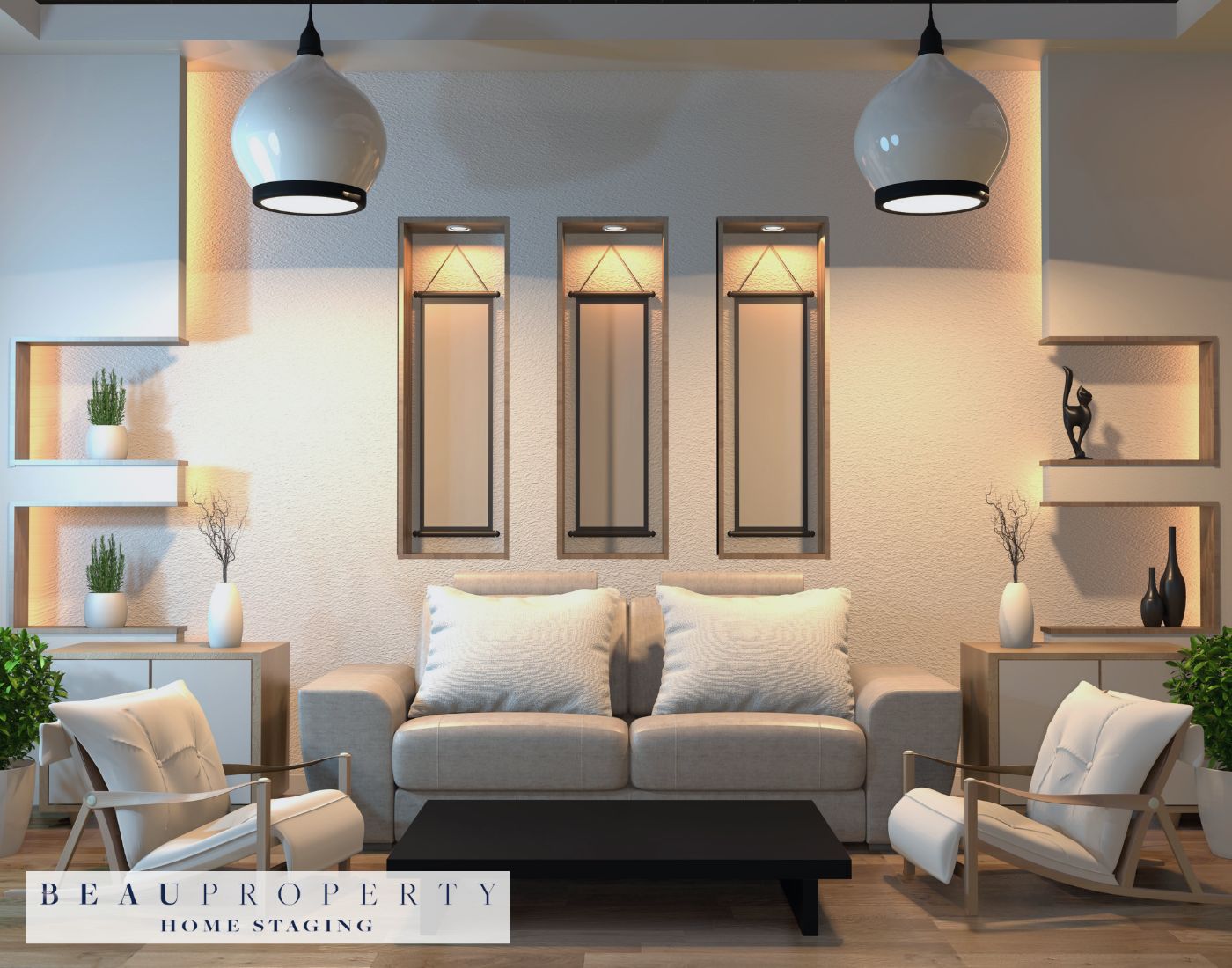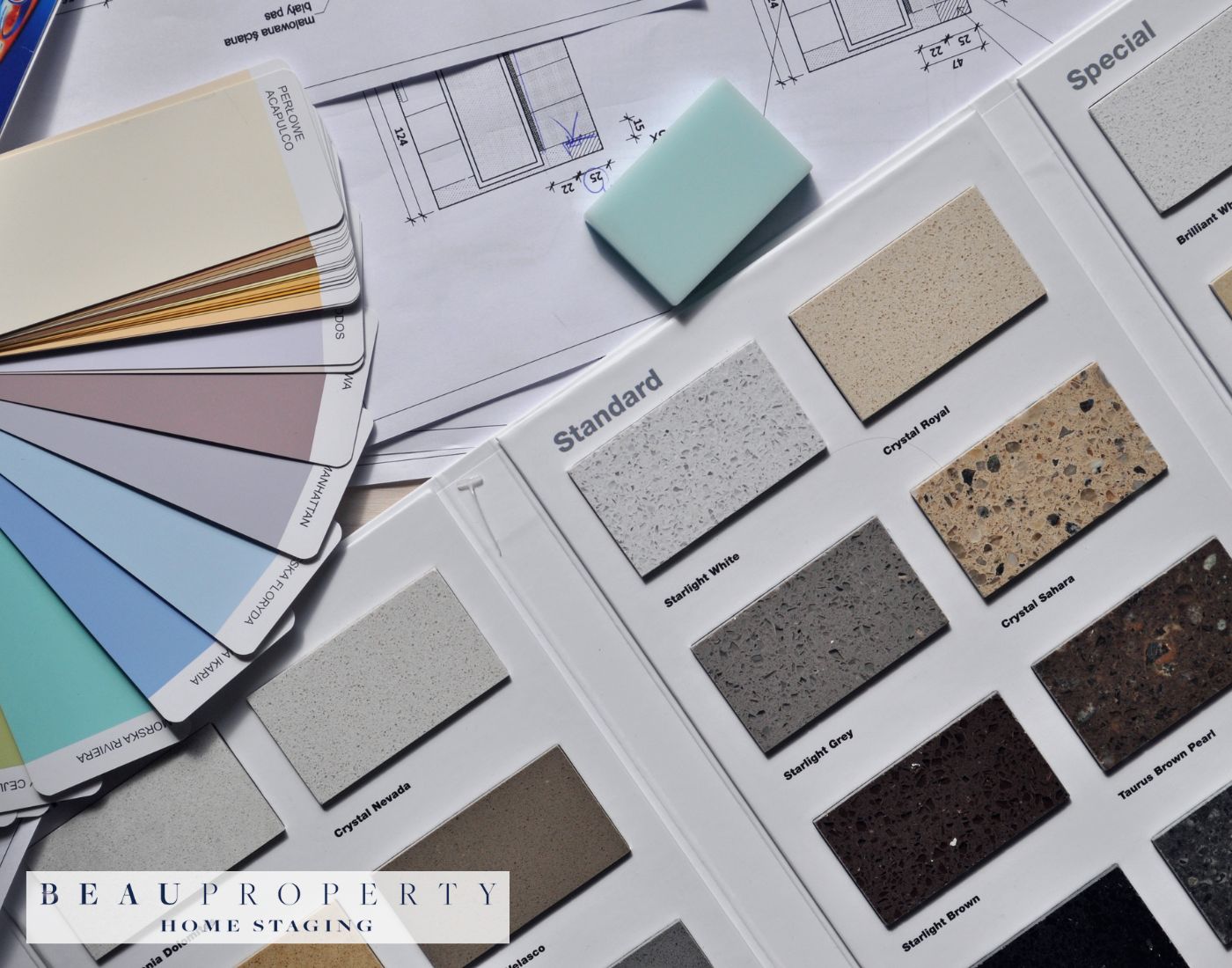Introduction to Property Staging & Interior Design Trends
Overview of the Importance of Property Staging in the UK Market
Property staging has cemented itself as a pivotal aspect of the UK real estate market. This practice significantly enhances a property’s appeal, making it more attractive to potential buyers. Staged properties are known to sell faster and often at a higher price compared to non-staged homes.
Brief Explanation of How Staging Differs from Interior Design
It’s crucial to distinguish between property staging and interior design. While both involve enhancing a space’s aesthetic, their objectives differ significantly. Interior design focuses on personalising a home to meet the specific tastes, needs, and lifestyle of the occupants. It’s about creating a space that the homeowners will love living in, considering their preferences and functionality requirements.
On the other hand, staging is geared towards making a property universally appealing to potential buyers. The goal is to depersonalise the space, highlight its best features, and create an inviting atmosphere that helps buyers envision living there. Whereas interior designers work closely with clients to tailor everything specifically to them, staging professionals aim to create a broad, marketable appeal.
The Role of Interior Design Trends in Creating Appealing Spaces for Potential Buyers
Current trends play a significant role in property staging. They provide fresh ideas on how to present spaces innovatively and attractively. Understanding these interior design trends allows stagers to create environments that resonate with buyers’ desires. For instance, utilising trending colour schemes or incorporating sustainable materials can make a substantial difference in a buyer’s perception of a property.
Staging trends can range from the strategic use of colour palettes to the integration of technology and sustainability into the design. However, it’s essential to strike a balance between trendy elements and timeless appeal. Overly trendy designs may become dated quickly, but a thoughtfully executed trend can make a home feel modern and inviting.
By staying attuned to the latest trends and understanding their potential impact, staging professionals can craft spaces that not only meet but exceed market expectations. This approach not only accelerates the sale process but also maximises the property’s value in a competitive market.
Color Schemes and Palettes
Two or Tri-Tone Color Schemes as a Leading Trend
One of the standout interior design trends for 2024 in property staging is the emergence of two or tri-tone colour schemes. These schemes, which incorporate up to three complementary colours, add depth and interest to a space without overwhelming potential buyers.
The Return of Brown and Earthy Tones in Interior Design
Brown is officially making a comeback in 2024, breaking away from the modern dominance of cooler greys. Various shades of brown, from whiskey and cognac to caramel and mocha, are gracing interiors with a sense of warmth and stability. Brown’s grounding qualities make it an ideal backdrop, particularly when integrated with natural materials such as wood and stone. Designers are using browns expansively to cultivate spaces that feel comforting and enduringly stylish.
Balancing Bold Colours with Neutral Backgrounds
The striking balance between bold colours and neutral backgrounds is essential in modern staging. Neutral tones, including beige, tan, and off-white, serve as ideal canvases that highlight dynamic accent colours without causing visual strain. Homes and Gardens report that beige is replacing grey as the go-to neutral for 2024, creating a warmer, more inviting foundation for bold hues like rich blues or vibrant greens.
When staging a property, incorporating bold elements judiciously against a neutral backdrop can give each room a more sophisticated, polished look. This technique allows the vivid shades to pop without overwhelming potential buyers, who might prefer more classic and adaptable staples.
Sustainable and Eco-Friendly Staging
As we move towards a more eco-conscious society, the importance of incorporating sustainable elements into property staging cannot be overstated. In 2024, there are several key themes when it comes to eco-friendly staging practices. Let’s delve into the specifics.
Incorporation of Sustainable Materials in Furniture and Decor
One of the most significant interior design trends in sustainable staging is the use of environmentally friendly materials for furniture and decor. This includes choosing pieces made from reclaimed wood, bamboo, and other renewable resources. Bamboo, for example, is a fast-growing plant that can be harvested in an eco-friendly manner, making it an excellent alternative to traditional wood.
Use of Energy-Efficient Lighting and Appliances
Lighting and appliances play a crucial role in staging, and opting for energy-efficient choices can make a significant impact. LED lighting, for example, uses up to 90% less energy than traditional incandescent bulbs and has a much longer lifespan.
Similarly, energy-efficient appliances reduce electricity consumption, leading to lower utility bills and a smaller carbon footprint. Appliances with the ENERGY STAR label are often the best choice as they meet strict energy efficiency guidelines, providing both performance and environmental benefits.
Upcycling and Repurposing Items for Unique Touches
Upcycling and repurposing are creative ways to incorporate sustainability into property staging. This involves taking old furniture or decor and transforming them into new, useful pieces. Not only is this environmentally friendly, but it also allows for unique, personalised touches in the staging process.
Additionally, repurposing items reduces waste and supports a circular economy, extending the life of materials and reducing the need for new resources. This approach not only benefits the environment but also results in individualised and compelling decor that can stand out to potential buyers.
Minimalism and Multifunctionality
The Continued Popularity of Minimalist Design in Staging
Minimalism is much more than just a trend; it is a design philosophy focused on simplicity and functionality. In the context of property staging, this approach is particularly effective. Simplified interiors allow spaces to appear larger, cleaner, and more inviting, which ultimately helps potential buyers imagine living there. By reducing clutter and focusing on essential, quality pieces, minimalist design offers a timeless appeal that enhances the overall property value.
Minimalist staging for 2024 takes the ethos of “less is more” to heart. Clean lines, neutral colour palettes, and functional decor elements are the core ingredients. Natural light is a key component here; big, unblocked windows, sheer curtains, and well-positioned mirrors help create bright and airy environments. By keeping the design straightforward and uncluttered, minimalist staging achieves a sense of tranquillity and spaciousness, making it easier for buyers to picture themselves living in the space.
Creating Multifunctional Spaces to Appeal to Modern Lifestyles
Modern lifestyles demand flexibility, especially as remote work and multi-use living spaces become increasingly common. Multifunctional spaces are a practical answer to modern needs, allowing different activities to coexist in harmony. In staging, it’s essential to showcase these versatile spaces effectively. For example, a living room can double as a home office with the incorporation of a stylish yet functional desk.
To create effective multifunctional spaces, versatility in furniture is vital. Items such as sofa beds, foldable tables, and wall-mounted desks are excellent choices. These pieces serve multiple purposes without compromising on style or taking up unnecessary room. Including these multifunctional elements in your staging effort allows potential buyers to see the full potential of the property, making it more attractive to a broader range of people.
Smart Furniture Choices for Flexibility and Adaptability
Adaptable furniture is at the heart of both minimalist and multifunctional designs. Transformable furniture pieces that serve more than one function are especially beneficial in smaller spaces. For instance, convertible sofas can transition from a seating area to a bed, while nesting tables can tuck away neatly when not in use. Such smart furniture choices provide practical solutions without sacrificing aesthetics.
The modern market offers a plethora of innovative furniture options that can cater to varying needs. For instance, Murphy beds, modular sofas, and extendable dining tables all contribute to a flexible living space. These furnishings not only maximise utility but also ensure that every square foot serves the homeowner’s needs efficiently.
Embracing both minimalism and multifunctionality in property staging can significantly enhance the appeal of a home by showcasing its flexibility and the potential for various lifestyles. This thoughtful combination can make even the smallest spaces feel expansive and versatile, ultimately boosting their desirability.
Technology Integration in Staging
Use of Virtual Reality (VR) and Augmented Reality (AR) in Property Showcasing
The integration of Virtual Reality (VR) and Augmented Reality (AR) is transforming property staging, offering buyers an immersive experience that bridges the gap between digital and reality. With VR, potential buyers can embark on virtual tours of properties without leaving their homes. Whether viewed through VR goggles for a fully immersive experience or via 3D tours on screens, these virtual showcases allow buyers to “walk through” homes, offering a realistic sense of space and layout. This can significantly shorten the decision-making process, as buyers feel more confident about the property’s features and layout.
AR, on the other hand, enhances on-site visits by overlaying digital information on real-world views. For instance, AR can display potential renovations or different furniture arrangements directly onto the room through a smartphone or tablet. This technology helps potential buyers visualise changes and modifications, aiding in more informed decision-making.
3D Home Design Tools for Visualisation and Planning
3D home design tools are indispensable in modern property staging, providing both designers and buyers with comprehensive tools to visualise and plan interiors.
By creating accurate and visually engaging models, these tools help buyers see the potential of a property in a way that photos and plain blueprints simply cannot. For staging professionals, using these tools means offering a tailored experience that can highlight a property’s best features and assist in setting realistic renovation expectations.
Smart Home Features as Selling Points
The modern buyer is increasingly tech-savvy, making smart home features not just a luxury but a significant selling point. Features like smart thermostats, lighting systems, and security cameras contribute to both convenience and energy efficiency. Home automation systems allow potential buyers to control various aspects of the home environment through their smartphones, adding a layer of comfort and security that is highly appealing in today’s market.
Smart homes often command higher prices and can sell faster due to these advanced features. Buyers are more inclined towards homes that offer energy savings, enhanced security, and the convenience of automation, making smart technology integration a critical aspect of property staging. This emphasis on technology aligns well with modern lifestyles, where digital connectivity and automation are becoming essential home utilities.
Textural Elements and Natural Influences
Incorporation of Natural Textures and Materials
The 2024 interior design trends place a strong emphasis on natural textures and materials, bringing a sense of the outdoors inside. Imagine a living room adorned with a rough-hewn stone accent wall, a reclaimed wood coffee table, and a mixture of soft and rugged fabrics. This blend not only enriches the aesthetic appeal but also adds depth and warmth to the space.
Natural materials, such as wood and stone, are gaining popularity for their versatile and timeless qualities. Wooden elements can range from light and airy pine to rich and dark mahogany, contributing to a cosy atmosphere. Stone can be incorporated as countertops, flooring, or even decorative pieces, bringing a touch of rugged luxury.
Use of Plants and Biophilic Design Elements
Biophilic design is another key trend, inviting elements of nature into our homes to enhance well-being and boost creativity. Houseplants play a significant role here, not just for their beauty but also for their air-purifying qualities. Incorporating plants like snake plants or peace lilies can create a tranquil and refreshing environment.
Living walls, also known as vertical gardens, are a striking way to introduce greenery and make a bold statement. These lush walls not only bring a visual connection to nature but also improve acoustics and air quality. Biophilic design also includes natural light, maximised through strategic placement of furniture and the use of large windows or skylights.
Balancing Comfort with Visual Appeal Through Textures
Balancing different textures is essential to create a space that’s both comfortable and visually appealing. Start with a neutral base, such as beige or tan walls, and layer various textures to add depth. For instance, combine a soft velvet sofa with a woven throw blanket and a silky rug. This variety in textures makes the space inviting and pleasant to touch.
Textures can also influence our emotions. Soft fabrics like wool or velvet can evoke a sense of warmth and comfort, while harder materials like stone or metal add a touch of sophistication. It’s about finding the right mix to create a space that feels well-rounded and harmonious.
By thoughtfully integrating natural textures, biophilic elements, and a balanced mix of soft and hard materials, property staging can transform a house into a welcoming and appealing home. This approach not only boosts the visual appeal but also connects potential buyers with the space on an emotional level, making it more likely for them to envision it as their future home.
Lighting and Atmosphere
Strategic Use of Lighting to Create Ambiance
Lighting plays an undeniable role in setting the atmosphere within a property. By using a combination of different lighting types—ambient, task, and accent lighting—you can create varied moods and highlight key features in a home. Ambient lighting, such as overhead fixtures or chandeliers, provides general illumination and ensures a room feels warm and inviting.
Task lighting, like under-cabinet lights in kitchens or reading lamps by armchairs, focuses on functional yet stylish illumination. Accent lighting, meanwhile, draws attention to specific elements like artwork or architectural details, creating visual interest and depth.
Incorporation of Statement Lighting Fixtures
Statement lighting fixtures are set to dominate 2024, acting as both functional and decorative centrepieces. Think along the lines of sculptural pendant lights or extravagant chandeliers that capture attention the moment you walk into a room. The trend includes everything from geometric patterns and oversized bulbs to fixtures made from recycled materials.
Interestingly, sculptural lighting will not only serve a functional purpose but also act as pieces of art, transforming any room’s tone and feel. For instance, the integration of natural and artistic elements, such as wooden beads or textured ceramics, can bring a focal point to rooms needing that extra spark.
Balancing Natural and Artificial Light for Optimal Staging
Balancing natural and artificial light ensures that properties feel both spacious and inviting. Integrating natural light can create welcoming spaces while improving energy efficiency. Strategic window placements, coupled with sheer curtains or reflective surfaces, can maximise the influx of natural daylight, making rooms appear larger and more cheerful.
On the other hand, artificial light should complement this natural illumination. For darker areas or evening showings, ensure that artificial light sources are well-distributed and potent enough to keep spaces well-lit without appearing harsh. Properly balanced lighting adds depth and brings new energy to interiors. The key is to achieve a harmonious blend where neither the natural nor the artificial light overpowers the other.
Conclusion: Implementing Interior Design Trends Effectively
Balancing Trendy Elements with Timeless Appeal
In the ever-evolving world of property staging, balancing trendy elements with timeless appeal is crucial for creating spaces that not only catch the eye but also stand the test of time. Interior Design trends can quickly become outdated and may not appeal to all buyers. By incorporating classic design elements such as clean lines, simple shapes, and natural materials like wood, stone, and linen, we can ensure a timeless look.
Tailoring Staging to Target Demographics and Local Markets
To make a property truly irresistible, understanding your target demographic is key. Different buyer personas have distinct preferences and needs.
Common strategies include:
- Demographic Research: Understanding the age, income, family size, and lifestyle of your potential buyers.
- Lifestyle Staging: Creating setups that reflect the likely lifestyle of the demographic, such as a functional family room or a stylish home office.
- Neutral Decor: While addressing specific tastes, maintaining a neutral palette can help appeal to a wider range of buyers.
The Importance of Professional Staging in Maximising Property Value
Professional property staging is not just about making a home look good; it’s a strategic tool to enhance the property’s perceived value. Staged homes spend significantly less time on the market and often sell at a higher price. Staging helps create a positive first impression, highlight functional spaces, and boost the overall appeal of the property.
Key Benefits of Professional Staging:
- Increased Marketability: Staging turns a house into a home, which helps buyers visualise themselves living in the space.
- Higher Sale Price: Proper staging can lead to an increased sale price, often providing a strong return on investment.
- Faster Sales: Homes that are staged typically spend less time on the market, making the selling process quicker.
By blending current interior design trends with timeless elements, focusing on the target demographic, and leveraging professional staging, property sellers can create highly appealing spaces that maximise market value and expedite sales.







